Dieffenbachia was brought from Central and Latin America, where it lives quietly and propagates in the wild. In the Eastern Hemisphere, for a century and a half, the plant has been cultivated as an ornamental. It looks picturesque and colorful, and home care does not require any special tricks and is available even to the most inept gardeners.
Despite the urgent recommendations not to include Dieffenbachia in home flower gardens due to its inherent toxicity, many flower growers still study diseases, transplantation and reproduction of exotics, post successful photos of grown specimens on the Internet, and keep them in home collections.

Content
Species and varieties
On gardening sites, mention is often made of 40 species of plants, but competent reference sources increase this amount by another two dozen. Home care does not present any particular difficulties, and knowledge of some of the nuances of breeding comes with the practical experience of a grower. In addition, you can always search for information on special sites or ask for advice on care on the forum.

Science knows more than 3 thousand species that belong to the luxurious family of aroid (Aronnikovye - according to another terminological version), distributed among 117 genera.
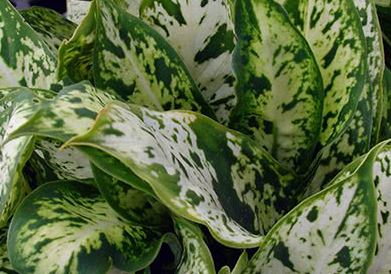
Types and names are certainly in every gardener's reference book, and motley-green photos are in photo galleries. Therefore, that the plant leaves a pleasant and bright impression, gently harmonizes with any interior, with significant growth it simply amazes the imagination.
In the TOP 5 in popularity, the following are certainly included:
- Dieffenbachia spotted. It is known as the painted, Latin name - Dieffenbachia Maculata. A magnificent plant with a powerful stem, the lower leaves, as they grow, can reach 40 cm. From the bottom to the top, it is literally studded with dense tiers of flat oblong leaves, making it seem that they were specially densified on the stem. The main advantage in indoor floriculture is its rapid growth, which makes it possible to achieve almost half of the maximum norm in a year. Having reached the meter, it stops in the distillation and further is present in the collection unchanged. To some extent, the popularity of the original variety was achieved due to the large number of varietal selection pearls that were created on its basis - Camille, Tropical Tiki, Tropic Marianne, Tropic Sun, Rudolph Roehrs.
- Dieffenbachia is lovely, or Dieffenbachia amoena, grows up to one and a half meters on a stably woody stalk that does not require any supports. Home care does not cause much trouble, calmly transfers both dry air during the heating period, and pruning, with which you can form a beautiful tree. Lovers manage to make a bush and a tightly packed bush and a tree with a luxurious leafy crown out of a pretty woman, in the photo of a well-groomed Dieffenbachia amoena and in natural growth, few will be indifferent.
- Dieffenbachia motley, painted, or Dieffenbachia picta, as well as spotted, is considered an ideal option for a home kindergarten on the windowsill, since with proper care it does not grow above one meter. With fairly impressive leaves reaching a length of almost half a meter, the stalk has a powerful stem, the huge foliage calmly holds without any backups. However, if you give the flower freedom and minimize care in home conditions before watering and top dressing, it can spread in width and in height, reach two meters or more.
- Dieffenbachia Leopold, among botanists known as Dieffenbachia Leopoldii. Costa Rican miracle, certainly exciting the hearts of lovers of exotic plants of unusual appearance and color. Lilac spots on dark green glossy leaves crossed out by a white contrasting vein give a special piquancy to the flower. Even the most thorough care will not make her grow above a few centimeters at home. But long leaves (sometimes up to 35 cm) on short green petioles can occupy half of the apartment window sill.
- Dieffenbachia Oerstedii - a magnificent plant, in the form of leaves somewhat resembling ficus. However, unlike another frequent pet of domestic greenhouses, its leaves are sharply outlined by a light line of symmetry. When viewed from above, the symmetrical arrangement of the leaves with respect to each other and to the strong stem is especially noticeable. At home, for a more advantageous visualization, Oersted's dieffenbachia, like ficus, are regularly dedusted, ensuring that the leaves are shiny and clean.
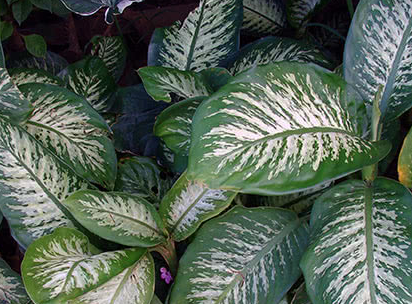
It is hybrids like Camilla, Mars, Tropic Snow, also known as the White Flame, are very beautiful. Compact, short and beautiful due to the large and clear light pattern on the leaves, Camilla, with its festively bright leaves framed by a clear green border, will not leave anyone indifferent.
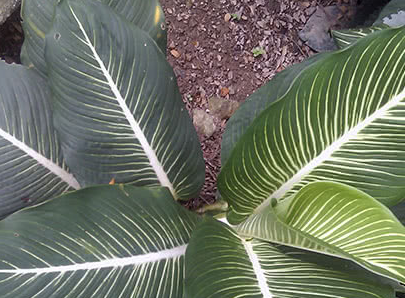
Home Care
In any description of a tropical alien, you can find a mention of the unpretentiousness and undemanding plants, care for which even the most naive amateur can do. Those who were dealing with difficult to growing plants requiring compliance with a certain temperature, air humidity and light level, an exotic bright plant may indeed seem unpretentious.
A newcomer, who brought a coveted acquisition from a flower shop and put it on the first window sill that has come across, after some time will be wondering why his leaves turn yellow, the trunk bent or bare from below, the dominant color became dull and unattractive.
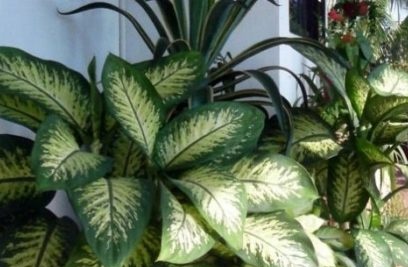
Any of these conditions is enough to find that the flower has dried leaves, or, on the contrary, the roots are rotting and the main decoration has become unpresentable.
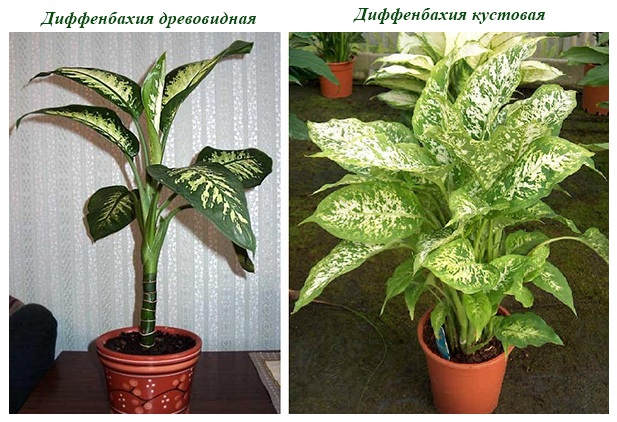
Watering
Fans of a flower from tropical latitudes are sure that only soft water can be used to water the plant. If there is no filter for water purification, then it is enough just to defend the irrigation material. Those who do not know how to get soft water for irrigation can use boiling, but if there is a lot of scale left on the walls of the kettle, once a month they will have to do the washing procedure of an earthen coma with a plant.
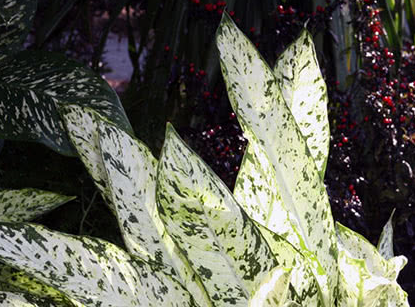
In winter, you can not do this, you can simply carry out plentiful watering. However, the main thing here is not to overdo it, because the main component of water care at home is not to overdo it with the amount of moisture.
Lighting
Careful supervision of exotics is a seasonal choice of the right place, because tropical plants need to provide winter and summer maintenance. And this means that Dieffenbachia, in conditions of a temperate climate still alien to it, cannot have one, permanent place. She needs a change in illumination, and for this she is seasonally moved to the windowsill with a higher or lower level of illumination. All the nuances of care should be strictly taken into account.
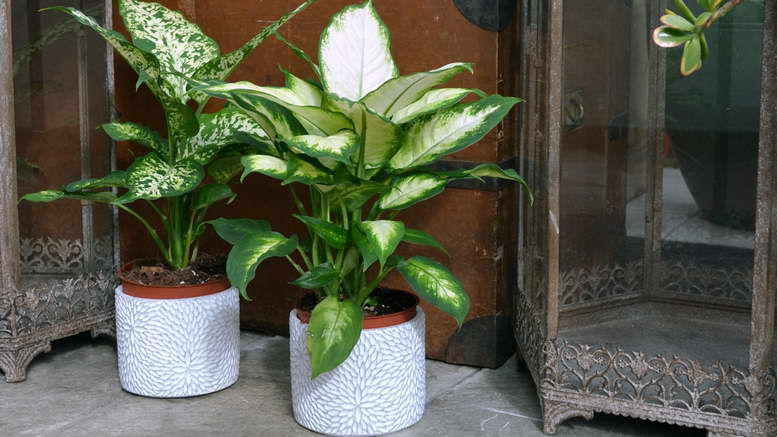
Experts advise to carefully monitor at what level of illumination the flower is located not just monthly but daily. In addition, one must take into account the type of Dieffenbachia, those varieties in which dark green leaves with a smaller amount of light pattern can live with a lower level of illumination. But the stream of light does not mean at all that direct sunlight should fall on the plant.
This can cause burns and lead to a loss of inherent decorativeness, the leaves will become dull and lose some of the whimsical pattern. Often, the well-being of an instance of a home collection depends on the degree of illumination; you need to transfer it seasonally to a room where in winter and autumn the greatest amount of light.
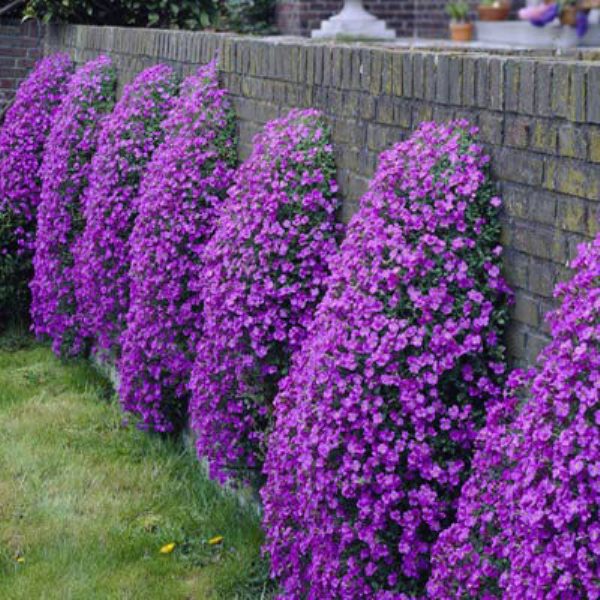 You may be interested in:
You may be interested in:Temperature mode
The optimum temperature for growing an exotic guest is + 20 ° C. This does not mean that the flower must be constantly kept at the same temperature. It normally tolerates both 23 ° C and 25 ° C (but, preferably, no more).
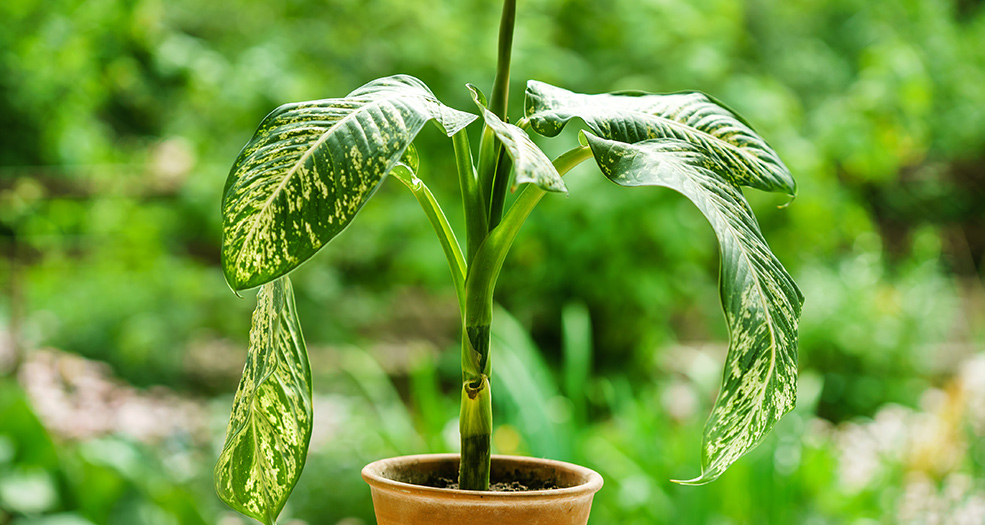
But at low temperatures, it inevitably begins to freeze and eventually dies. + 16 ° C for dieffenbachia of any kind - this is already an extremely low temperature. The recommended seasonal camber is 18-22 ° C, with this difference, you can maintain both the health and the decorativeness of your pet.
Top dressing
Fertilizers and nutrient solutions are an indispensable condition for the successful existence and beautiful appearance of Dieffenbachia. For her, the presence of fertilizers in the soil is provided every decade of the month. It is better to buy fertilizers not in reserve, but at the right time and apply to the soil in a lower concentration than the experts recommending.
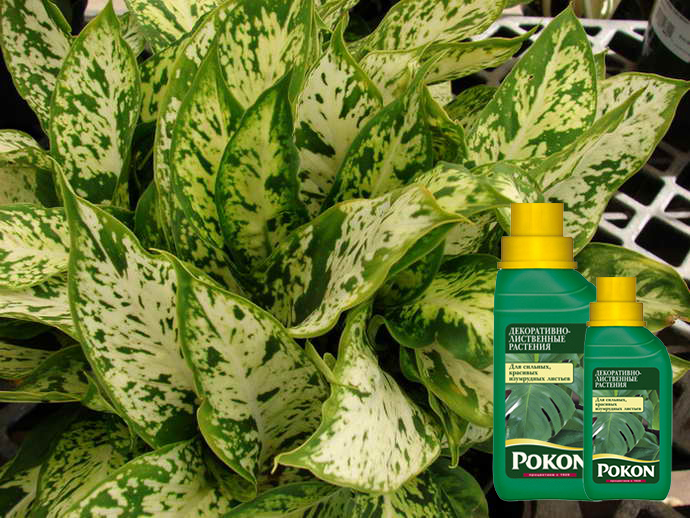
In fertilizers for an exotic plant, lime should never be contained. Mineral compounds should be preferred, especially if Dieffenbachia with variegated leaves lives in the house. The introduction of organic matter sometimes leads to the disappearance of spots, in this case it is recommended to simply reduce the frequency of feeding.
Pruning
The need for pruning is determined by the falling of the lower leaves - this is a sure sign of advancing aging, the need for anti-aging procedures.But this term is often understood as cutting off the top, undertaken to reduce the intensity of growth, otherwise the flower will go high and fill the space allocated to it.
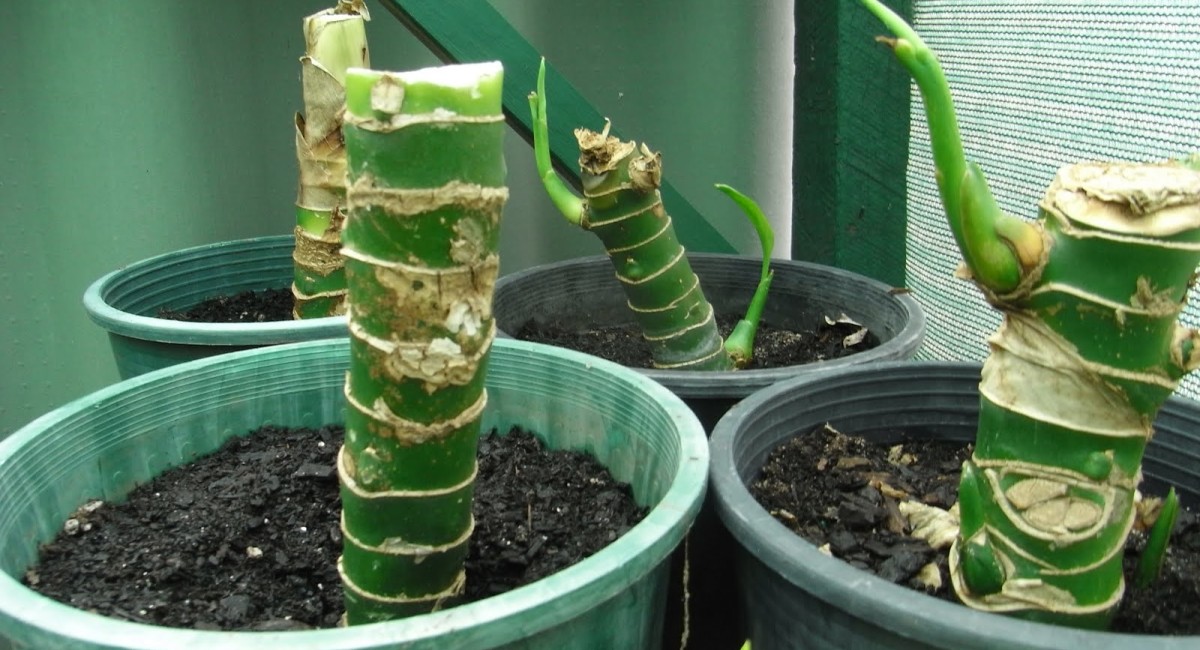
A slice drawn below the nodal joint of the stem is treated with plant charcoal so that the plant does not suffer from loss of juice. If Dieffenbachia has the peculiarity of letting out additional layering, and there are too many leaves, they can also be partially trimmed, subsequently used as planting material.
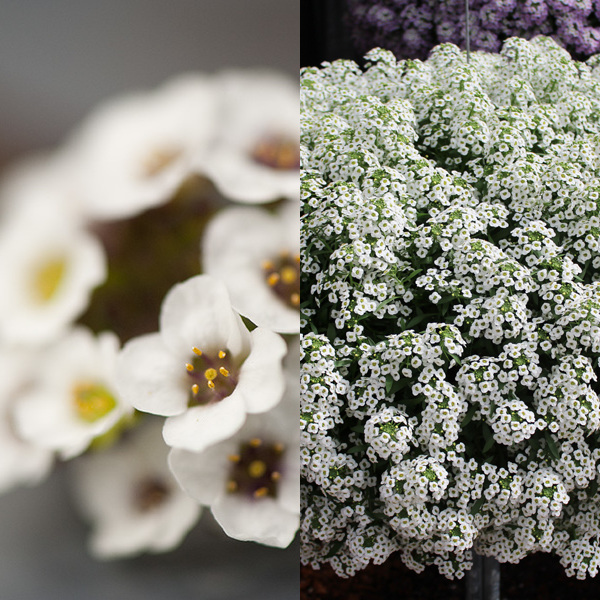 You may be interested in:
You may be interested in:Breeding
The happy feature of Dieffenbachia is its multiplicity and multivariance of propagation methods.

Soil and pot selection
Indoor plant Do not plant on a growth in a too large pot. This will lead to the development of a powerful root system and weak leaf cover, but the main beauty of Dieffenbachia lies in large and succulent leaves. The soil is slightly acidic; for example, sphagnum and peat mixed with sand and sheet soil. It is very good to add chopped charcoal.
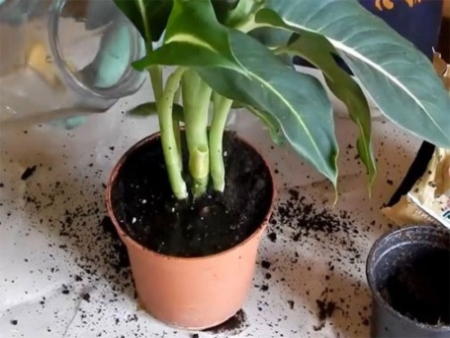
Types of rooting
Dieffenbachia can be propagated by cuttings, layering and stems. There is another option for seed propagation, but it is complicated, and only professional breeders succeed. Bush dieffenbachia can produce additional specimens by simply dividing the overgrown bush, and the top is cut off from the tree variety for transplantation if it has grown greatly.
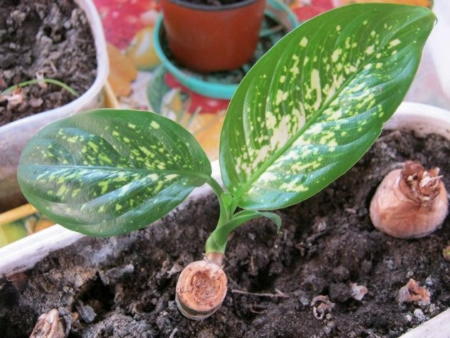
Transfer
Correct transplantation, pruning, switching to winter and summer time is what exotic plants need to come from the hemisphere, where in summer it is summer and in summer it is also another time of the year. Genetic memory makes the plant live according to the usual schedule laid down by nature, look for similar conditions for development, find ways to satisfy needs or minimize them for survival. Caring for a flower at home is not only watering and transplanting from a smaller vessel to a larger one, as it grows.

Diseases and Pests
A good host, meticulously choosing the soil and following other plants, usually does not have such problems. No one is safe from getting mycelium of the fungus or transfer from outdoor plants. Anthracose spores can be brought in with water for irrigation, and fusarium can be brought in with the untreated substrate used during transplantation. A plant infected with a virus is destroyed because it has no chance of salvation, and it is easy to infect other plants.
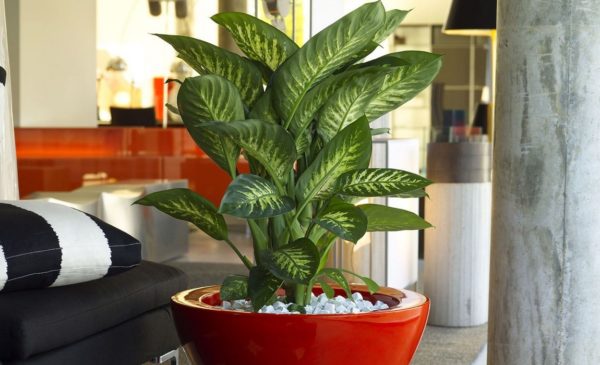
Of the pests, there may be habitual aphids, scale insects, worms or spider mites, you can fight them with traditional methods.
Problems of growing Dieffenbachia
Unpleasant moments can occur in any grower and gardener. With experience, a gradual ability to cope with the situation and give up plants that have no chance of recovery will come.
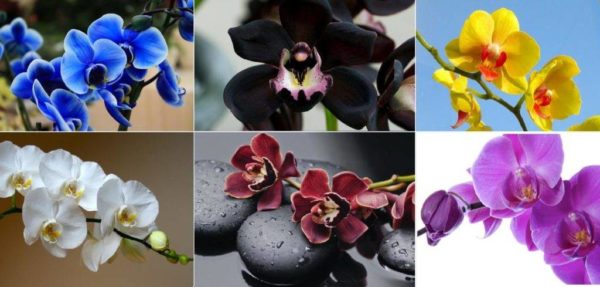 You may be interested in:
You may be interested in:Why leaves turn yellow
Flooded with water, the plant stops the growth and reproduction of its main decorative advantage - leaves. If Dieffenbachia is constantly in a wet pool - this is the main reason why the leaves turn brown, rot, turn yellow and simply fall off. Once a resident of the tropics, a decorative copy of the home collection is naturally susceptible to the level of humidity in the room.
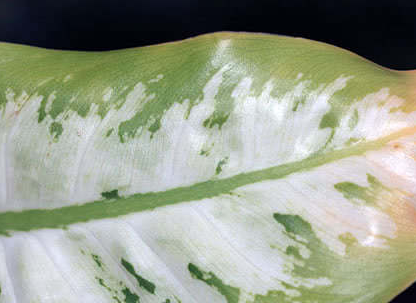
In the greenhouse it can be very simply adjusted - there are special devices for this. You will have to buy a humidifier at home, although you can do without it if there is an aquarium or an evaporator in the same room. Sometimes for this purpose a pallet with constantly wet moss is used, which plays the role of an additional decorative component.
The leaves are dry
The appearance of dry spots may be associated with anthracosis. The appearance of the disease is equally associated with an excess of moisture in the pot or with overdried indoor air.
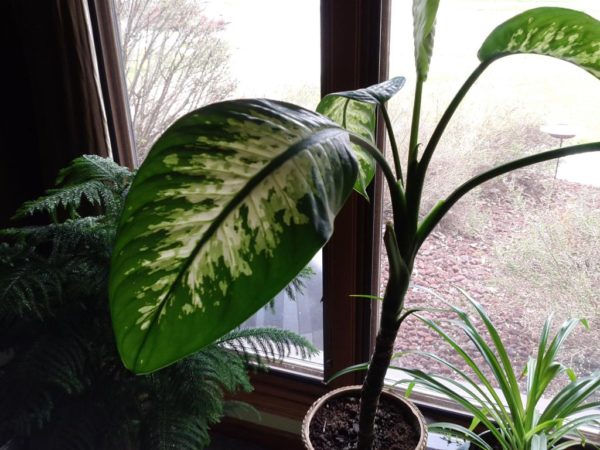
The tips of the leaves are dry
This problem arises for reasons not obvious to the beginning grower. He may overlook obvious facts, such as a plant that is overheated by heating, or, conversely, reacts negatively to temperature changes caused by a lack of heat in the batteries. Soil can become acidic from excess moisture and cause dry tips. There is another, unlikely reason - spraying a flower with water dust in the dark.
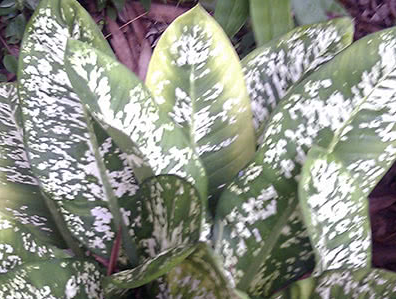
Wither leaves
There may be several reasons - lack of lighting, lack of necessary nutrient components in the soil, damage to the root system, or even exposure to direct sunlight
Why Dieffenbachia cries
This is a feature of the plant, probably related to its tropical genes. The ability to evaporate excess moisture during tropical showers helps Dieffenbachia survive in difficult seasonal periods. There is nothing wrong with this phenomenon. This is absolutely physiological.
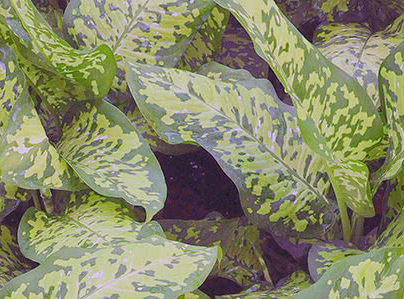
Why do the leaves curl
This phenomenon is not uncommon with a lack of heat. The plant elementarily freezes, so the lower leaves are twisted to reduce evaporation, and, therefore, natural cooling. If not only the lower ones are affected, you need to look for pests and engage in their destruction.




 Sow in the ground, without seedlings: 10 beautiful and unpretentious flowers
Sow in the ground, without seedlings: 10 beautiful and unpretentious flowers Platicodon planting and outdoor care
Platicodon planting and outdoor care Hosta - planting and care in the open ground in the Urals
Hosta - planting and care in the open ground in the Urals Oleander - care and growing at home
Oleander - care and growing at home